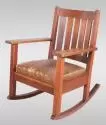These Chairs Were Made For Rockin’

A quick glance through the 1910 “Craftsman Furniture Catalog” published by Gustav Stickley reveals no fewer than 18 different styles of rocking chairs available to his customers.
High-back, short-back, V-back, ladder-back, H-back, open-arm, closed-arm, arched or straight seat — and that does not include the options of a hard leather seat, a rush seat, a spring seat cushion or sheepskin upholstery.
As evidence of their popularity, when it opened in 1913 the Grove Park Inn featured a rocking chair in every one of their 150 guest rooms, plus a large number of Heywood-Wakefield wicker rockers on the open terraces and in the spacious Great Hall.
Judging by the number of Arts & Crafts rockers that appear in shops, shows and auctions, a high percentage of them have survived today. And since you can slip a rocking chair into just about any room in the house, they remain just as popular now as they did a hundred years ago.
Deciding which one to buy — and which one is the best deal — does require a little comparison among the variations produced by different Arts & Crafts manufacturers.
The low, armless sewing rockers popular at a time when women stayed home and spent part of each day mending clothes, doing embroidery or knitting scarves are the least popular today. Designed for young girls or petite women, they are difficult for men to get into or out of without harming either themselves or the rocker. The tall-back versions are pleasing to look at, but the low seat still makes them impractical for most people.
Collectors today definitely prefer arms on their rocking chairs, both to aid in getting up and to make the rocking more comfortable. A nice wide arm supported by a corbel attached to the leg beneath it makes any rocking chair that much more attractive and desirable. Adding a row of slats, either wide or narrow, beneath the arm makes the rocking chair appear more massive, which collectors will certainly reward with higher demand (lower photo).
The ultimate rocking chair by most standards is the rocking Morris chair, featuring both closely-spaced slats under the arms and a supportive corbel on each of the four legs. The adjustable back makes this chair even more attractive to collectors.
The type of seat cushion does not affect the rocker’s desirability as much as the condition of it. The hard leather wrap-around seats proved to be the most durable, although some often don’t appear capable of supporting a large adult much longer. The sheepskin or soft leather cushions have nearly all been replaced by now. If done properly, replaced upholstery will not affect the value of the rocker, especially to someone who wants to be able to use it without fear of damaging the fragile, often brittle, original leather.
Consider carefully just how you plan to use any rocking chair you might buy, then shop accordingly. One thing is for sure: you will have plenty to choose from.
Good Luck!
Bruce

